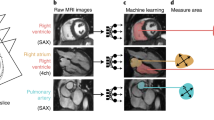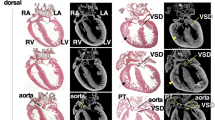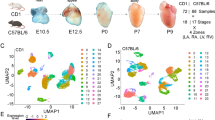Abstract
Heterotaxy arises from a failure of the embryo to establish normal left-right asymmetry and is known to affect 3% of infants with congenital heart disease. A recessive mutation causing heterotaxy was recovered in a mouse mutagenesis screen focused on congenital heart defects. Homozygote mutants exhibit abnormal situs in the thoracic and abdominal cavities. Dextrocardia, levocardia, or mesocardia was seen together with right pulmonary isomerism and complex structural heart defects in the single ventricle spectrum. A dominant chamber of left ventricular morphology positioned on the left or right is seen together with transposition of the great arteries. Right atrial isomerism with or without total anomalous pulmonary venous connection was observed in half of the mutants. Because ciliary motion at the embryonic node is required for the specification of laterality, we examined the tracheal epithelia of newborn mice as a proxy for the nodal cilia. However, videomicroscopy showed no defect in ciliary motion. Genome scanning using polymorphic microsatellite markers mapped the mutation to a 3.3 Mb interval on mouse chromosome 7. None of the genes previously described for familial heterotaxy were found in this interval, indicating a novel mutation in this mouse model of heterotaxy.
Similar content being viewed by others
Log in or create a free account to read this content
Gain free access to this article, as well as selected content from this journal and more on nature.com
or
Abbreviations
- CHD:
-
congenital heart defect
- EFIC:
-
episcopic fluorescence image capture
- PCD:
-
primary ciliary dyskinesia
- TAPVC:
-
total anomalous pulmonary venous connection
References
Belmont JW, Mohapatra B, Towbin JA, Ware SM 2004 Molecular genetics of heterotaxy syndromes. Curr Opin Cardiol 19: 216–220
Ware SM, Peng J, Zhu L, Fernbach S, Colicos S, Casey B, Towbin J, Belmont JW 2004 Identification and functional analysis of ZIC3 mutations in heterotaxy and related congenital heart defects. Am J Hum Genet 74: 93–105
Bartram U, Wirbelauer J, Speer CP 2005 Heterotaxy syndrome: asplenia and polysplenia as indicators of visceral malposition and complex congenital heart disease. Biol Neonate 88: 278–290
Ticho BS, Goldstein AM, Van Praagh R 2000 Extracardiac anomalies in the heterotaxy syndromes with focus on anomalies of midline-associated structures. Am J Cardiol 85: 729–734
Kuehl KS, Loffredo C 2002 Risk factors for heart disease associated with abnormal sidedness. Teratology 66: 242–248
Alonso S, Pierpont ME, Radtke W, Martinez J, Chen SC, Grant JW, Dahnert I, Taviaux S, Romey MC, Demaille J, Bouvagnet P 1995 Heterotaxia syndrome and autosomal dominant inheritance. Am J Med Genet 56: 12–15
Casey B, Cuneo BF, Vitali C, van Hecke H, Barrish J, Hicks J, Ballabio A, Hoo JJ 1996 Autosomal dominant transmission of familial laterality defects. Am J Med Genet 61: 325–328
Arnold GL, Bixler D, Girod D 1983 Probable autosomal recessive inheritance of polysplenia, situs inversus and cardiac defects in an Amish family. Am J Med Genet 16: 35–42
Kosaki K, Casey B 1998 Genetics of human left-right axis malformations. Semin Cell Dev Biol 9: 89–99
Mercola M, Levin M 2001 Left-right asymmetry determination in vertebrates. Annu Rev Cell Dev Biol 17: 779–805
Yost HJ 2001 Establishment of left-right asymmetry. Int Rev Cytol 203: 357–381
Shiratori H, Hamada H 2006 The left right axis in mouse: from origin to morphology. Development 133: 2095–2104
Tsukui T, Capdevila J, Tamura K, Ruiz-Lozano P, Rodriguez-Esteban C, Yonei-Tamura S, Magallon J, Chandraratna RA, Chien K, Blumberg B, Evans RM, Belmonte JC 1999 Multiple left-right asymmetry defects in Shh(−/−) mutant mice unveil a convergence of the shh and retinoic acid pathways in the control of Lefty-1. Proc Natl Acad Sci U S A 96: 11376–11381
Okada Y, Takeda S, Tanaka Y, Belmonte JC, Hirokawa N 2005 Mechanism of nodal flow: a conserved symmetry breaking event in left-right axis determination. Cell 121: 633–644
Caspary T, Larkins CE, Anderson KV 2007 The graded response to sonic hedgehog depends on cilia architecture. Dev Cell 12: 767–778
Liu A, Wang B, Niswander LA 2005 Mouse intraflagellar transport proteins regulate both the activator and repressor functions of Gli transcription factors. Development 132: 3103–3111
Yu Q, Shen Y, Chatterjee B, Siegfried BH, Leatherbury L, Rosenthal J, Lucas JF, Wessels A, Spurney CF, Wu YJ, Kirby ML, Svenson K, Lo CW 2004 ENU induced mutations causing congenital cardiovascular anomalies. Development 131: 6211–6223
Shen Y, Leatherbury L, Rosenthal J, Yu Q, Pappas MA, Wessels A, Lucas J, Siegfried B, Chatterjee B, Svenson K, Lo CW 2005 Cardiovascular phenotyping of fetal mice by noninvasive high-frequency ultrasound facilitates recovery of ENU-induced mutations causing congenital cardiac and extracardiac defects. Physiol Genomics 24: 23–36
Rosenthal J, Mangal V, Walker D, Bennett M, Mohun TJ, Lo CW 2004 Rapid high resolution three dimensional reconstruction of embryos with episcopic fluorescence image capture. Birth Defects Res C Embryo Today 72: 213–223
Neuhaus IM, Beier DR 1998 Efficient localization of mutations by interval haplotype analysis. Mamm Genome 9: 150–154
Wenink AC 1981 Embryology of the ventricular septum. Separate origins of its components. Virchows Arch A Pathol Anat Histol 390: 71–79
van's Gravesande KS, Omran H 2005 Primary ciliary dyskinesia: clinical presentation, diagnosis and genetics. Ann Med 37: 439–449
De Iongh RU, Rutland J 1995 Ciliary defects in healthy subjects, bronchiectasis, and primary ciliary dyskinesia. Am J Respir Crit Care Med 151: 1559–1567
Fliegauf M, Olbrich H, Horvath J, Wildhaber J, Zariwala M, Kennedy M, Knowles MR, Omran H 2005 Mislocalization of DNAH5 and DNAH9 in respiratory cells from patients with primary ciliary dyskinesia. Am J Respir Crit Care Med 171: 1343–1349
Ibanez-Tallon I, Gorokhova S, Heintz N 2002 Loss of function of axonemal dynein Mdnah5 causes primary ciliary dyskinesia and hydrocephalus. Hum Mol Genet 11: 715–721
Okada Y, Nonaka S, Tanaka Y, Saijoh Y, Hamada H, Hirokawa N 1999 Abnormal nodal flow precedes situs inversus in iv and inv mice. Mol Cell 4: 459–468
Peeters H, Devriendt K 2006 Human laterality disorders. Eur J Med Genet 49: 349–362
Satir P, Christensen ST 2007 Overview of structure and function of mammalian cilia. Annu Rev Physiol 69: 377–400
Nonaka S, Tanaka Y, Okada Y, Takeda S, Harada A, Kanai Y, Kido M, Hirokawa N 1998 Randomization of left-right asymmetry due to loss of nodal cilia generating leftward flow of extraembryonic fluid in mice lacking KIF3B motor protein. Cell 95: 829–837
Marszalek JR, Ruiz-Lozano P, Roberts E, Chien KR, Goldstein LS 1999 Situs inversus and embryonic ciliary morphogenesis defects in mouse mutants lacking the KIF3A subunit of kinesin-II. Proc Natl Acad Sci USA 96: 5043–5048
Kennedy MP, Omran H, Leigh MW, Dell S, Morgan L, Molina PL, Robinson BV, Minnix SL, Olbrich H, Severin T, Ahrens P, Lange L, Morillas HN, Noone PG, Zariwala MA, Knowles MR 2007 Congenital heart disease and other heterotaxic defects in a large cohort of patients with primary ciliary dyskinesia. Circulation 115: 2814–2821
Oh SP, Li E 1997 The signaling pathway mediated by the type IIB activin receptor controls axial patterning and lateral asymmetry in the mouse. Genes Dev 11: 1812–1826
Qin H, Percival-Smith A, Li C, Jia CY, Gloor G, Li SS 2004 A novel transmembrane protein recruits numb to the plasma membrane during asymmetric cell division. J Biol Chem 279: 11304–11312
Johnson JE 2003 Numb and Numblike control cell number during vertebrate neurogenesis. Trends Neurosci 26: 395–396
Uemura T, Shepherd S, Ackerman L, Jan LY, Jan YN 1989 numb, a gene required in determination of cell fate during sensory organ formation in Drosophila embryos. Cell 58: 349–360
Niikura Y, Tabata Y, Tajima A, Inoue I, Arai K, Watanabe S 2006 Zebrafish Numb homologue: phylogenetic evolution and involvement in regulation of left-right asymmetry. Mech Dev 123: 407–414
Kim SJ, Kim WH, Lim HG, Lee CH, Lee JY 2006 Improving results of the Fontan procedure in patients with heterotaxy syndrome. Ann Thorac Surg 82: 1245–1251
Cohen MS, Schultz AH, Tian ZY, Donaghue DD, Weinberg PM, Gaynor JW, Rychik J 2006 Heterotaxy syndrome with functional single ventricle: does prenatal diagnosis improve survival?. Ann Thorac Surg 82: 1629–1636
Morales DL, Braud BE, Booth JH, Graves DE, Heinle JS, McKenzie ED, Fraser CD Jr 2006 Heterotaxy patients with total anomalous pulmonary venous return: improving surgical results. Ann Thorac Surg 82: 1621–1627; discussion 1627–1628.
Author information
Authors and Affiliations
Corresponding author
Additional information
This work was supported by funding from NHLBI DIR (ZO1-HL005701).
Rights and permissions
About this article
Cite this article
Aune, C., Chatterjee, B., Zhao, XQ. et al. Mouse Model of Heterotaxy with Single Ventricle Spectrum of Cardiac Anomalies. Pediatr Res 63, 9–14 (2008). https://doi.org/10.1203/PDR.0b013e31815b6926
Received:
Accepted:
Issue date:
DOI: https://doi.org/10.1203/PDR.0b013e31815b6926
This article is cited by
-
The Drosophila homologue of MEGF8 is essential for early development
Scientific Reports (2018)



